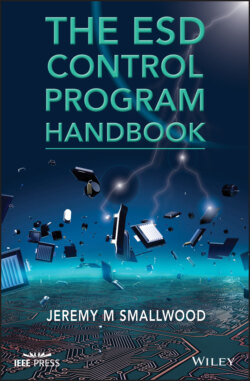Читать книгу The ESD Control Program Handbook - Jeremy M. Smallwood - Страница 80
2.9 Electromagnetic Interference (EMI)
ОглавлениеESDs can give waveforms that have very fast (nanosecond or subnanosecond) rise times, high peak current levels of tens of amps, and oscillatory waveforms. Discharge current rise rates can be of the order of 109 A s−1, and electrostatic fields may collapse with rates of the order of 1012 V s−1. The ESD source may radiate or conduct strong transient electromagnetic fields over a wide frequency band up to GHz frequencies.
These induce transients in nearby conductors, especially tracks or wires of significant length that can act as efficient antennas at the frequencies radiated in the discharge. This radiated or conducted interference can cause upset or malfunction to nearby equipment such as test equipment. Giant magnetoresistive (GMR) heads have been demonstrated to be damaged by this type of ESD transient (Wallash and Smith 1998).
EMI can also be an issue in highly automated facilities where automated test equipment (ATE) can test large numbers of production items. EMI may cause the ATE to register a product fail or to otherwise malfunction (Tamminen et al. 2015). This can represent a loss of production or output.
